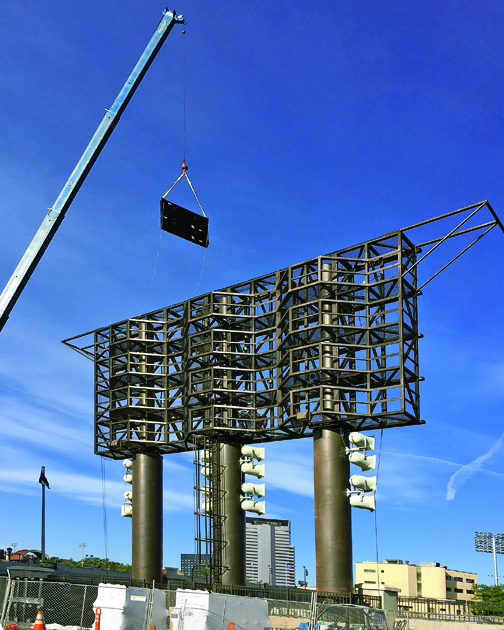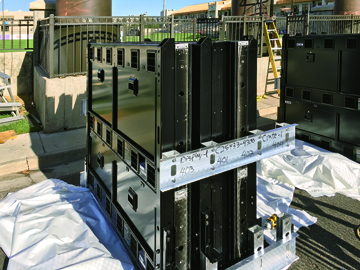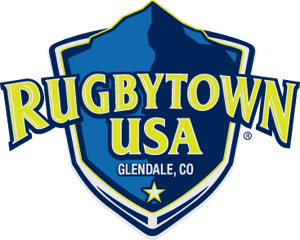by Kurt Woock
Writer for and on behalf of the City of Glendale
 At 1,727 square feet, the new video screen installed at Infinity Park earlier this summer covers an area the size of a three bedroom house. It’s more than twice the size of the previous video board. But the gains can be measured in more ways than sheer size.
At 1,727 square feet, the new video screen installed at Infinity Park earlier this summer covers an area the size of a three bedroom house. It’s more than twice the size of the previous video board. But the gains can be measured in more ways than sheer size.
“The city planned to replace the old video screen this year,” said Linda Cassaday, Glendale’s deputy city manager. The screen had reached the end of its projected lifetime. Screen technology has not only made significant advancements in the near decade that has elapsed since Infinity Park opened, but also the old technology is truly obsolete: Cassaday said it was becoming difficult, if not impossible, to find replacement parts.
Cassaday said the new screen, and the company that made it, needed to fit a few requirements. First, the screen needed to be versatile enough to accommodate the many needs at Infinity Park, which include showing live video from rugby matches, displaying statistics and advertisements, and broadcasting movies during Monday Movie Madness (the last of which wasn’t even on the city’s radar when the first screen was installed). Second, in order to conserve time and money, the video screen needed to be able to use the old screen’s existing platform. Third, the company providing the screen needed to be able to have a proven track record of being able to respond quickly to problems when they arise. After interviewing a few companies, Cassaday said the top choice was clearly Daktronics.
Daktronics is a South Dakota-based company that has been making electronic scoreboards, programmable display systems, and large screen video displays since 1968. Both the company headquarters and the manufacturing facility are in Brookings, South Dakota, which was an important factor for Cassaday. “When you have an issue, you want to reach out locally, especially when it comes to technica l problems,” she said. At one point, the video screen had an issue the day before a tournament. Needing a fix as soon as possible, the crew at Infinity Park was at the stadium at 1 a.m. in order to connect with the provider, which is located halfway around the world. With parts only one state away, addressing pressing issues quickly becomes much easier.
l problems,” she said. At one point, the video screen had an issue the day before a tournament. Needing a fix as soon as possible, the crew at Infinity Park was at the stadium at 1 a.m. in order to connect with the provider, which is located halfway around the world. With parts only one state away, addressing pressing issues quickly becomes much easier.
Chances are you’ve already seen a Daktronics product. Mile High Stadium, Coors Field, and Pepsi Center all use Daktronics video displays. In fact, nearly every major professional sports team in the country uses a Daktronics video screen in their home stadium, as do many college stadiums. Although this will be the first Daktronics installation at a rugby stadium in the U.S., Daktronics is no stranger to Rugby as Twickenham in London and the Adelaide Oval in Australia both use Daktronics screens.
Each board at Daktronics is custom made for the customer. The new screen at Infinity Park is the largest size that the current support system can handle. It measures 24 feet by 53 feet (the old board was 20 feet by 33 feet) and uses 13HD LED technology, the best currently available. “When you go to any sporting event and look up at the big screen, a lot of fans expect it to be as clear as their screen at home,” said Eric Cain, regional sales rep for Daktronics. “In the past, it was a bit more grainy. In the last seven years, we were able to get that clarity. That’s the goal: To make a live event realm be as good as or better than your living room.” In addition to the main video board, a new ribbon display will stretch 250 feet along the east end of the stadium.
All that new space will enhance the in-game experience for fans and will give advertisers more value for their sponsorship dollars. Instead of a static sign with a company logo printed on it, like the ones that surrounded the old video screen, the new video screen will be able to have moving logos, will be able to incorporate sponsors into in-game video, and can allow more sponsors to be featured in more interesting ways. “We can increase sponsorship opportunities because of it, recouping our cost that much more quickly,” Cassaday said. Companies can, for example, sponsor halftime or each time the home team scores. Cain said other stadiums have used the ribbon board to display statistics, freeing the main scoreboard for larger video and to engage with fans by displaying live social media feeds and conducting in-game fan polls.
The relationship between Daktronics and Infinity Park will not end when the installation is complete. Daktronics also provides software packages that display information on the screen and has in-state, full-time technicians, removing the need for Infinity Park to find contractors who are familiar enough with their video screen. Cain, who grew up in and lives in Colorado, is looking forward to a long tenure at Infinity Park. “I can’t express how pumped Daktronics is to be part of the first rugby stadium in the U.S.”

